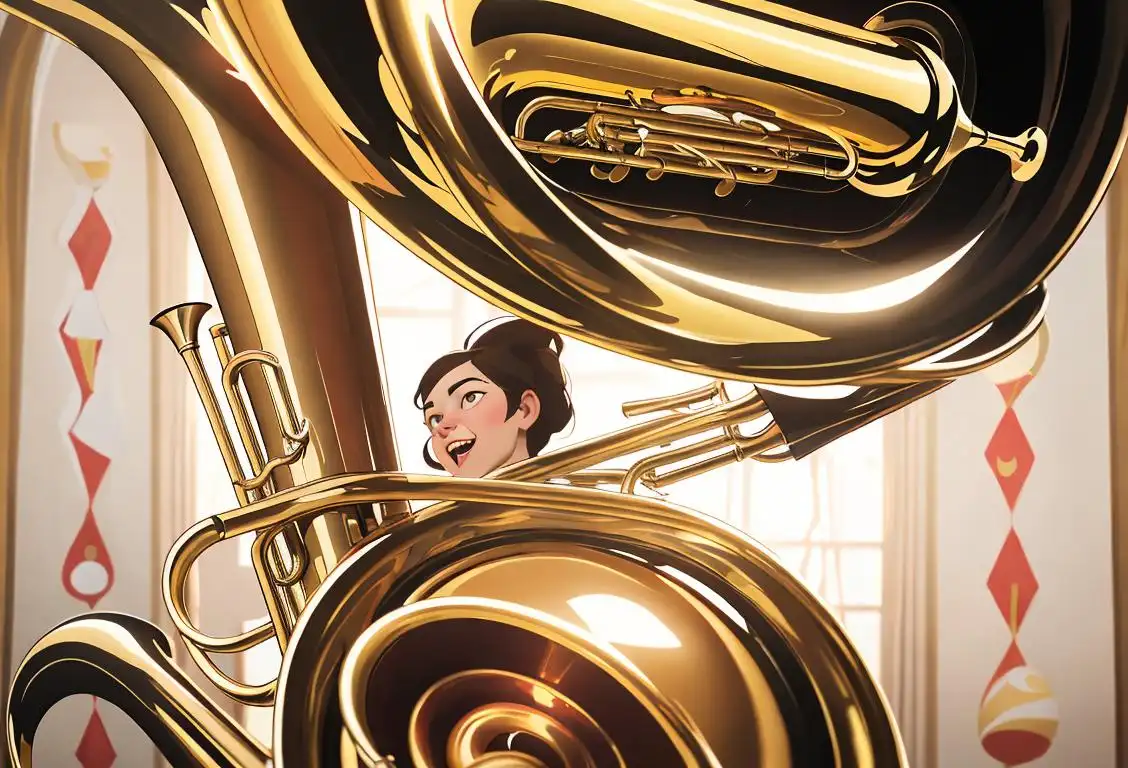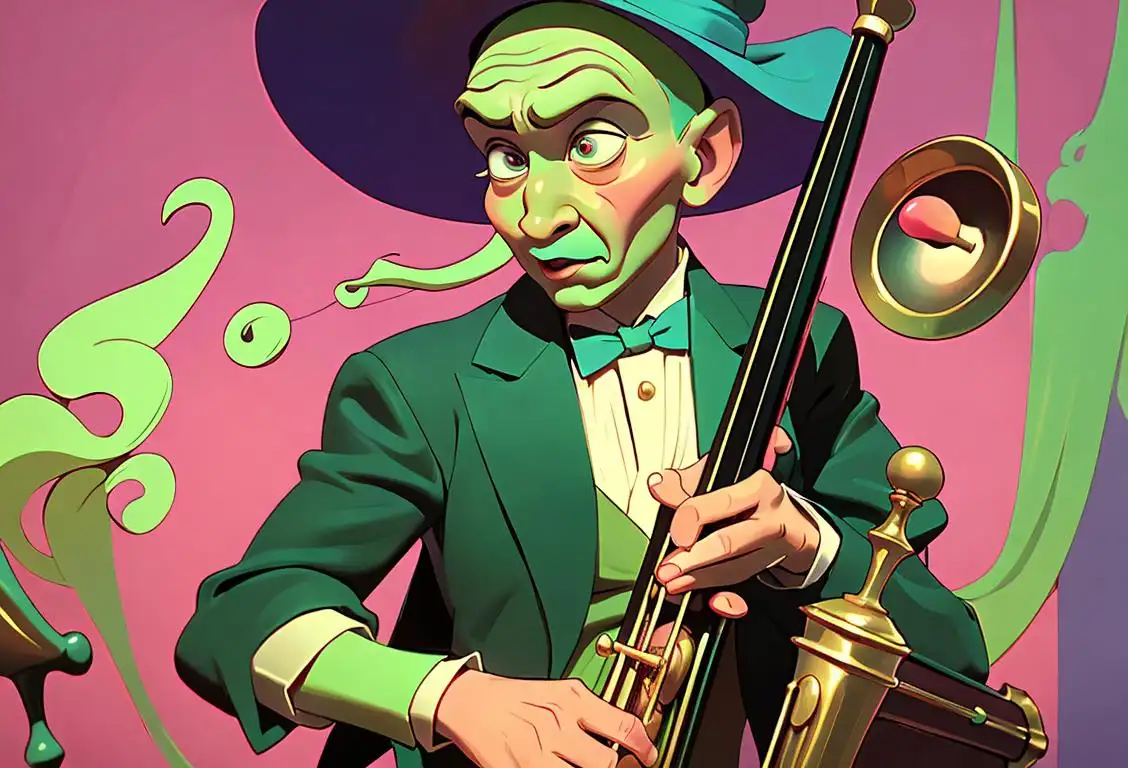National Saxaphone Day

Hey there, saxophone enthusiasts! Get ready to jazz up your day because it's National Saxophone Day! Grab your favorite brass instrument, put on some smooth jazz, and let's dive into the history of this melodic celebration.
When is Saxaphone Day?
It's national saxaphone day on the 6th November.
The Birth of National Saxophone Day
On this special day, we commemorate the inventive genius behind the saxophone – Adolphe Sax. Born on November 6, 1814, in Belgium, Sax was a talented instrument maker who crafted various brass and woodwind instruments.
However, Sax's most significant contribution to the musical world was his invention of the saxophone. Combining elements from both woodwinds and brass instruments, the saxophone offers a unique and expressive sound that captivates listeners.
In 1846, Adolphe Sax patented his creation, and since then, the saxophone has become an essential part of numerous musical genres, including jazz, classical, and even pop music.
Celebrating National Saxophone Day
To honor National Saxophone Day, countless saxophone enthusiasts, musicians, and music lovers take to social media to share their favorite saxophone performances, memories, and even saxophone-themed jokes. It's a day to show your love for this soulful instrument and appreciate the incredible talent of saxophonists worldwide.
Want to join in on the celebration? Dust off your old saxophone, or if you're new to the instrument, give it a whirl! No saxophone? No problem! Listen to your favorite saxophone tunes, or attend a live saxophone performance in your area.
Did You Know?
Here's a fun fact to impress your friends: The saxophone family consists of several different types, including the soprano, alto, tenor, and baritone saxophones. Each type brings its distinct character and range, enriching the soundscape of any musical ensemble.
History behind the term 'Saxaphone'
1840
The Invention of the Saxophone
In 1840, the term 'saxophone' came into existence when it was invented by Belgian musical instrument designer Adolphe Sax. Adolphe Sax was motivated to create a new instrument that would bridge the gap between brass and woodwind instruments. He wanted to invent an instrument that could be more versatile and offer a wider range of tone and expression. Thus, the saxophone was born.
1840
Birth of the inventor
The first step in the origin of the term 'saxophone' starts with the birth of its inventor, Adolphe Sax. Adolphe Sax was born on November 6, 1814, in Dinant, Belgium. He was a skilled instrument maker and a passionate musician. Sax was always on the lookout for ways to improve existing musical instruments and create new ones.
1814
Adolphe Sax is born
In the year 1814, a talented Belgian musician and instrument maker named Adolphe Sax was born. Sax grew up surrounded by music and had a knack for creating new and unique musical instruments.
1814
The Birth of the Saxophone
In 1814, Adolphe Sax, a Belgian musical instrument designer and musician, was born. He is credited with the invention of the saxophone. Adolphe Sax was highly skilled in instrument craftsmanship and had a deep understanding of acoustics and the mechanics of brass and woodwind instruments. He spent many years experimenting with various designs before perfecting the saxophone in the 1840s.
1840
Birth of Adolphe Sax
In the year 1840, Adolphe Sax, a Belgian musical instrument maker, was born. Sax showed an early interest in creating new instruments and dedicated his life to inventing and perfecting various musical instruments.
1841
The Birth of the Saxophone
In the year 1841, a Belgian instrument maker named Adolphe Sax created a new musical instrument that would change the world of music forever. He called it the 'saxophone'. Adolphe Sax was inspired by a combination of brass and woodwind instruments and aimed to create an instrument that could bridge the gap between the two.
1840
Early Invention
In the year 1840, the saxophone was invented by Belgian instrument maker, Adolphe Sax. He wanted to create an instrument that could bridge the gap between the brass and woodwind families. Sax designed the saxophone using elements from both families, resulting in a unique instrument with a conical brass body and a single-reed mouthpiece, similar to a clarinet.
1802
Invention of the saxophone
In the year 1802, the saxophone was invented by Adolphe Sax, a Belgian musical instrument designer. Sax was inspired to create a new instrument that could bridge the gap between woodwinds and brass instruments, combining the best qualities of both. He spent years experimenting and refining his design until he finally showcased his invention to the world.
1840
Invention of the Saxophone
The year 1840 marked the invention of the saxophone by a Belgian instrument maker named Adolphe Sax. Sax was inspired to create a new instrument that combined the best qualities of both the woodwind and brass families. The saxophone was designed to be played with a single-reed mouthpiece and featured a conical metal body with finger keys similar to those of a clarinet.
1840
Invention of the Saxophone
The saxophone was invented by Belgian instrument maker Adolphe Sax in the year 1840. Adolphe Sax was a skilled instrument designer and musician who sought to create an instrument that combined the best qualities of brass and woodwind instruments. The saxophone was designed to bridge the gap between the powerful sound of brass instruments and the expressive capabilities of woodwind instruments.
1841
Birth of Adolphe Sax
In the year 1841, Adolphe Sax was born in Belgium. He was a skilled instrument maker and musician who would later go on to revolutionize the world of music with his invention.
1846
Patent for the Saxophone
In 1846, Adolphe Sax received a patent for his creation, the saxophone. This patent protected his invention and gave him exclusive rights to manufacture and sell the instrument. Sax continued to refine and improve the design of the saxophone, ultimately creating a family of saxophones with different sizes and ranges.
1840s
Adolphe Sax's Experiments
During the 1840s, Adolphe Sax worked on designing and experimenting with different types of wind instruments. He sought to develop a hybrid instrument that blended the characteristics of brass and woodwind instruments, creating a unique and versatile sound.
1844
Patent Grant for the Saxophone
In 1844, Adolphe Sax received a patent for the saxophone, officially recognizing him as the inventor. This patent protected his unique design and granted him exclusive rights to manufacture and sell saxophones. With the patent secured, Sax began producing saxophones in various sizes and pitches, ranging from sopranino to contrabass.
1846
The birth of the saxophone
In the year 1846, Adolphe Sax introduced the saxophone to the world. Combining elements of both woodwind and brass instruments, the saxophone had a unique sound that quickly caught the attention of musicians and composers. Sax patented his invention on June 28, 1846, and named it 'saxophone' after himself. The term 'saxophone' came into existence, forever associated with Adolphe Sax's groundbreaking creation.
1846
Patent and Early Developments
In 1846, Adolphe Sax patented his invention and began marketing it. The saxophone gained popularity quickly, especially in military bands and orchestras. It was known for its unique sound and ability to blend well with other instruments. Sax continued to refine and improve the saxophone, creating different sizes and models to suit different musical genres and playing styles.
1840
The birth of the saxophone
In the year 1840, Adolphe Sax invented a family of instruments known as saxophones. His goal was to create an instrument that combined the power of brass instruments with the agility of woodwind instruments. The saxophone was designed to have a conical body made of brass and a single reed mouthpiece, similar to that of a clarinet.
1846
The Invention of the Saxophone
In 1846, Adolphe Sax invented the saxophone. Seeking to create an instrument that bridged the gap between the brass and woodwind families, he designed the saxophone with a single reed mouthpiece and a conical brass body. This unique combination produced a rich and versatile sound that quickly gained popularity.
1846
Patent granted for the saxophone
In 1846, Adolphe Sax was granted a patent for the saxophone. This patent protected his invention and allowed him to establish his own saxophone factory in Paris. The patent also marked the official recognition of the saxophone as a unique and distinct musical instrument, solidifying its place in the world of music.
1842
Patent Application
In 1842, Adolphe Sax applied for a patent for his instrument, which he called the 'saxophone.' The patent described the instrument's construction and demonstrated Sax's intentions to revolutionize the music industry by creating an instrument with a powerful and versatile sound. Sax's patent was granted on March 28, 1846, solidifying the birth of the saxophone.
1840s
Perfecting the Saxophone
During the 1840s, Adolphe Sax patented and further refined his design for the saxophone. He aimed to create a versatile instrument that could bridge the gap between woodwind and brass. His final design featured a conical brass body with finger keys similar to those of a clarinet. The saxophone's unique sound and playability soon caught the attention of musicians and composers, leading to its growing popularity.
1846
Patent for the Saxophone
In 1846, Adolphe Sax received a patent for the saxophone. This patent granted him exclusive rights to produce and sell saxophones. Sax continued to refine his invention and introduced various sizes and types of saxophones, including soprano, alto, tenor, and baritone saxophones.
1846
Significant Public Debut
After receiving the patent, Sax showcased his newly invented saxophone at the Brussels Exhibition in 1846. This exhibition marked the saxophone's significant public debut, attracting the attention of musicians, composers, and instrument manufacturers. It was during this time that the saxophone began to gain recognition and popularity among musicians across Europe.
1857
Widespread Adoption by Military Bands
The saxophone gained popularity in military bands during the mid-19th century. Its unique sound and versatility made it a favored instrument among military musicians. Sax's saxophones were widely used in military ensembles, particularly in France and Belgium, and later spread to other countries as well.
1857
Saxophone's popularity among military bands
By the year 1857, the saxophone began to gain popularity, particularly among military bands. The instrument's powerful sound and versatility made it well-suited for outdoor performances and marching bands. Its distinct voice added a new dynamic to the traditional military band sound, and it quickly became a staple in such ensembles.
1846
Introduction to the Public
In 1846, the saxophone made its public debut at the Brussels Exhibition. Adolphe Sax showcased his invention, which quickly garnered attention and admiration. The saxophone's rich and expressive tone, combined with its versatility across various musical genres, sparked immense interest among both professional musicians and amateurs alike.
1846
Patent for saxophone
In 1846, Adolphe Sax was officially granted a patent for his saxophone design. The patent protected Sax's invention and allowed him to manufacture and sell saxophones. This marked a significant milestone in the history of the saxophone, as it paved the way for its future popularity and impact on music.
1920s
Jazz Age and Saxophone's Rise to Fame
During the 1920s, the saxophone became the iconic instrument of the Jazz Age. Jazz musicians embraced the saxophone for its expressive capabilities and its ability to convey emotions and improvisation. Legendary jazz musicians such as Charlie Parker and John Coltrane further popularized the saxophone, pushing its boundaries and showcasing its versatility.
1846
Introduction to Military Bands
By 1846, saxophones gained popularity in military bands across Europe. The saxophone's powerful and versatile sound made it an ideal addition to brass and woodwind ensembles. Its ability to play both melodic lines and provide harmony or supporting tones made it a valuable instrument in military music, leading to its widespread adoption.
1846
Patent for the Saxophone
In the year 1846, Adolphe Sax received a patent for his invention, the saxophone. The saxophone incorporated elements from both brass and woodwind instruments while using a single reed mouthpiece, similar to a clarinet, to produce sound.
1847
Patent for the Saxophone
In 1847, Adolphe Sax received a patent for his saxophone design. This patent protected his invention and allowed him to commercialize and further develop the instrument. Sax continued to refine the saxophone to better suit the needs of musicians and improve its playability.
1851
Recognition and popularity
After the initial introduction, the saxophone started gaining recognition and popularity. It found a place in military bands and soon made its way into classical and jazz music. The saxophone's expressive and versatile nature allowed musicians to convey emotions in a way that no other instrument could. As its popularity grew, so did the term 'saxophone,' becoming widely known and synonymous with the remarkable instrument.
1853
Military Band Adoption
The saxophone gained popularity in military bands during the mid-19th century. Its unique sound and versatility made it an ideal instrument for these ensembles. Saxophones were used to add a distinctive element to military music, and their presence in military bands helped to popularize the instrument.
1857
French military band adopts the saxophone
By the year 1857, the French military band, under the direction of Napoleon III, began to incorporate the saxophone into their ensemble. This decision greatly contributed to the saxophone's rise to prominence and popularity. The unique and expressive sound of the saxophone found its way into military music, creating a distinct and captivating sound that stood out among other instruments.
1950s
Saxophone in Popular Music
In the 1950s, the saxophone found its way into popular music genres such as rock and roll and rhythm and blues. Artists like Bill Haley and the Comets, King Curtis, and Clarence Clemons incorporated the saxophone into their music, adding a unique and soulful element to the sound. The saxophone became synonymous with the energetic and vibrant music of the era.
1853
Introduction to the Military Bands
By 1853, the saxophone had gained recognition and popularity, particularly within military bands. Its powerful sound and ability to project over other instruments made it an ideal choice for marching bands and ensembles. The saxophone became an integral part of military music, further propelling its recognition.
1920s
Jazz era and the saxophone
The 1920s marked the rise of the Jazz Age, a time of cultural revolution and musical innovation. The saxophone played a pivotal role during this era, becoming synonymous with jazz music. Jazz legends such as Charlie Parker, Coleman Hawkins, and John Coltrane showcased the incredible expressiveness and improvisational capabilities of the saxophone, establishing it as an iconic instrument in jazz and popular music.
1857
Adoption by Military Bands
In 1857, the saxophone found a new home in military bands. The French military recognized the unique sound and versatility of the instrument, leading to its adoption into military music ensembles. The saxophone's bold and vibrant tone made it an excellent choice for producing powerful and melodic sounds in outdoor settings, making it an ideal addition to military bands.
1894
Jazz and Saxophone
The saxophone became closely associated with jazz music in the late 19th and early 20th centuries. Jazz musicians embraced the saxophone's expressive qualities and used it as a key instrument in their performances. Notable jazz saxophonists like Sidney Bechet and Coleman Hawkins played a crucial role in establishing the saxophone as a prominent jazz instrument.
1846-1847
Saxophone's Early Reception
Following the patent, the saxophone gained attention and started to be adopted by military bands in Europe. The instrument's unique tonal quality and its ability to blend well with other brass and woodwind instruments contributed to its popularity.
1920s
Jazz Age and Saxophone Solos
During the 1920s, the saxophone played a significant role in the Jazz Age. Jazz musicians embraced the saxophone for its ability to convey emotion and improvisation. Saxophone solos became a defining feature of jazz music, with legendary saxophonists like Charlie Parker and John Coltrane pushing the boundaries of the instrument's capabilities.
20th century
The modern saxophone
Throughout the 20th century, the saxophone continued to evolve and find its place in various genres of music. It became an integral part of big band ensembles, jazz orchestras, and even found its way into popular music genres like rock and funk. The term 'saxophone' became firmly established in the music lexicon, representing not only the instrument but also the cultural significance and musical impact it had produced.
1853
Saxophone's Entrance into Orchestras
In 1853, the saxophone made its entrance into classical orchestras. Composers such as Hector Berlioz and Richard Wagner started writing parts specifically for the saxophone. Despite its initial warm reception, the saxophone faced resistance from traditionalists who believed it did not belong in classical music. Nevertheless, its unique timbre and expressive capabilities gained recognition over time.
1857
The Saxophone Spreads Globally
By 1857, the saxophone had gained popularity beyond Belgium, spreading to other European countries and even crossing the Atlantic Ocean to the United States. The instrument's presence in military bands and orchestras further solidified its place in the musical world. Composers such as Hector Berlioz and Richard Wagner recognized the saxophone's unique qualities and began incorporating it into their compositions.
1960s
Rock 'n' Roll and the saxophone
In the 1960s, the saxophone made its mark in the world of rock 'n' roll. Artists like Bruce Springsteen, Clarence Clemons, and King Curtis brought the soulful sound of the saxophone into the rock genre, adding a touch of blues and jazz influence to their music. The saxophone became synonymous with powerful solos and catchy hooks, contributing to the evolution of rock 'n' roll.
20th Century
Jazz and Saxophone
During the 20th century, the saxophone found its true home in jazz music. Legendary saxophonists like Charlie Parker and John Coltrane pushed the boundaries of the instrument, using it to create improvisational and expressive melodies. The saxophone's ability to convey emotion and its distinctive sound became synonymous with the art form of jazz, leaving an indelible mark on the genre.
1920s
Big Band Era
During the 1920s, the saxophone became a staple in big bands. Big band music, characterized by its energetic and vibrant sound, relied heavily on saxophones to create a rich and full ensemble texture. Prominent bandleaders such as Duke Ellington and Count Basie prominently featured saxophone sections in their arrangements, further solidifying the saxophone's place in popular music.
1920s
Jazz Era and Saxophone Popularity
The saxophone's popularity soared during the jazz era in the 1920s. Legendary saxophonists such as Charlie Parker, John Coltrane, and Coleman Hawkins contributed greatly to the instrument's prominence in jazz music. The saxophone's ability to convey a range of emotions through its expressive and soulful sound made it perfect for improvisation, leading to its integration into various jazz styles.
Today
Continued Influence and Diverse Usage
The saxophone continues to be a beloved and widely used instrument in various musical genres. It is a staple in jazz, classical, pop, and even contemporary genres. The saxophone's expressive capabilities, wide range, and distinctive sound make it a favorite among musicians and listeners alike, and its cultural impact remains significant to this day.
Present day
Legacy and global recognition
In the present day, the term 'saxophone' is recognized and understood worldwide. It has become a symbol of creativity, passion, and virtuosity in music. With its iconic sound, the saxophone continues to capture the hearts of millions of listeners around the globe. Whether it's played in a jazz club, a concert hall, or on the streets, the term 'saxophone' carries with it a rich history and an enduring legacy.
20th Century and Beyond
Diverse Musical Genres and Popularity
The saxophone has continued to be a prominent instrument in various musical genres throughout the 20th century and beyond. It has found its place in classical music, rock, pop, funk, and even contemporary genres. The saxophone's expressive qualities and versatile range have made it an enduring favorite among musicians and audiences alike.
1920s
Jazz era and the saxophone
During the 1920s, the saxophone found its true calling in the world of jazz music. Jazz musicians, such as Louis Armstrong, Charlie Parker, and John Coltrane, embraced the saxophone and elevated its status as a leading instrument in jazz ensembles. The saxophone's versatility, expressiveness, and ability to mimic the human voice made it the perfect instrument for improvisations and solos, defining the iconic sounds of the jazz era.
1920s-1930s
Jazz's Love Affair with the Saxophone
In the 1920s and 1930s, the saxophone became synonymous with jazz music. It quickly became the favored instrument of jazz musicians, featuring prominently in improvisation and solos. Renowned jazz musicians such as Charlie Parker and John Coltrane pushed the boundaries of saxophone playing, exploring new techniques and styles that further popularized the instrument.
1857
Saxophone in Classical Music
In the year 1857, the renowned French composer Hector Berlioz included the saxophone in his orchestral composition 'Chant Sacramentel.' This marked one of the saxophone's earliest appearances in classical music, expanding its reach beyond military bands.
1920s
Jazz Era and Saxophone's Rise to Prominence
In the 1920s, the saxophone soared in popularity during the Jazz Age. Its expressive and emotive capabilities perfectly suited the improvisational nature of jazz music. Renowned jazz musicians like Charlie Parker, John Coltrane, and Coleman Hawkins became synonymous with the saxophone, contributing to its enduring association with jazz.
20th Century
Variations and Modern Development
Throughout the 20th century, the saxophone continued to evolve and diversify. Various sizes and types of saxophones were invented, ranging from the soprano to the bass saxophone. With advancements in manufacturing techniques and materials, the saxophone became more accessible to musicians worldwide. It became a staple in various genres, including classical, pop, and funk.
20th Century
Versatility and Adaptation
Throughout the 20th century, the saxophone continued to evolve and adapt to various musical genres. From classical to rock, funk to pop, the saxophone found its way into a wide range of musical styles. Its melodic and expressive nature made it a favorite among soloists and session musicians alike.
1920s
Jazz Age and Saxophone
During the 1920s, the saxophone became an integral part of the Jazz Age. Its expressive and adaptable nature allowed musicians to explore new sounds and techniques, revolutionizing the jazz genre and influencing countless musicians in the years to come.
20th and 21st centuries
The saxophone in various genres
Throughout the 20th and 21st centuries, the saxophone continued to make its mark in various musical genres. It became an integral part of big bands, soul music, rock and roll, funk, and even pop music. From the smooth sounds of artists like Stan Getz to the fiery solos of rock legends like Bruce Springsteen's E Street Band, the saxophone has remained a versatile and beloved instrument across a wide range of musical styles.
1960s
Integration into Popular Music
In the 1960s, the saxophone became a staple in popular music genres. Artists like David Bowie, Pink Floyd, and Bruce Springsteen incorporated the saxophone into their tracks, adding a distinctive flair to their sound. The saxophone's versatility allowed it to transcend musical boundaries, fitting well within the rock, pop, and R&B genres.
Present
Versatility and continued popularity
Today, the saxophone remains a beloved and versatile instrument in various genres of music. From classical to pop, funk to R&B, the saxophone has the ability to captivate audiences with its rich tone and expressive capabilities. It continues to be a popular choice for solo performances, jazz ensembles, and symphony orchestras, ensuring its enduring presence in the world of music.
Present Day
Saxophone's Ubiquity and Versatility
Today, the saxophone continues to captivate audiences in various musical genres. It is a prominent instrument in jazz, funk, pop, and even classical music. Its soulful and expressive tone allows musicians to convey raw emotions and connect with listeners on a profound level. The saxophone's cultural impact is undeniable, shaping the sound of countless songs and leaving an enduring legacy in the world of music.
20th Century
Saxophone's Popularity Soars
Throughout the 20th century, the saxophone continued to gain popularity across various genres of music. The instrument's ability to convey emotion and its distinct sound made it a favorite among musicians ranging from jazz and R&B to rock and pop.
1986
International Saxophone Symposium
In 1986, the first International Saxophone Symposium was held in the United States. The event brought together saxophonists, scholars, and enthusiasts, fostering an exchange of ideas and furthering the development of saxophone music. Today, saxophone symposiums and conventions are held globally, celebrating the instrument and its diverse community.
Present Day
Saxophone's Enduring Status
Today, the saxophone remains a beloved instrument worldwide. Its versatility is showcased in a multitude of musical styles, from classical and contemporary compositions to jazz improvisations and memorable solos. The saxophone's expressive power continues to captivate audiences and inspire new generations of musicians.
Did you know?
Did you know that the saxophone was originally intended to be used in military bands? The saxophone's powerful sound and versatility made it a valuable asset for military orchestras in the 19th century.Tagged
celebration music instrumentsFirst identified
6th November 2015Most mentioned on
6th November 2015Total mentions
12Other days
Drummer Day
Harp Day
Flute Day
Tuba Day
Saxaphone Day
Piccolo Day
Viola Day
Dogg Day
Giggs Day
Music Day








